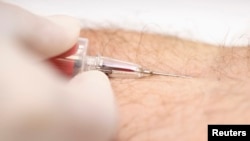The World Health Organization is launching a global campaign to stop the use of dirty syringes and needles that are responsible for millions of life-threatening infections each year. The new WHO initiative aims to prevent unsafe injections by promoting so-called “smart” syringes that cannot be used more than once.
Injections are supposed to cure illnesses and save lives. And, in most cases, they do. But, the World Health Organization warned many of the 16 billion injections administered every year spread disabling, often deadly infections because of the re-use of contaminated syringes and needles.
WHO reports around 10 percent of injections used for immunizations and procedures such as blood transfusions and injectable contraceptives are generally safe. The problems lie with the remaining 90 percent that inject medicine through the muscle or skin. WHO says a great many of these injections are not necessary or could be replaced by oral medication.
Worse still, coordinator of WHO's Department of HIV/AIDS, Gundo Aurel Weiler, warned these injections often are not safe and are driving the spread of deadly infectious diseases worldwide.
“We do know that 1.7 million Hepatitis B infections are probably attributable to unsafe injections and more than 300,000 Hepatitis C infections every year. So, this is a major contribution to the viral Hepatitis epidemics," Weiler noted. "In 2000, there was an estimate that around 10 percent of new HIV infections were attributable to unsafe injections, now for 2010, this has been reduced to less than one percent…so there is a clear reduction of HIV transmission attributable to unsafe injection-also due to the promotion of safe injection policies.”
Despite this progress, Dr. Weiler noted an estimated 33,800 people a year still are contracting HIV through unsafe injections. He said deadly infections are transmitted when a dirty syringe or needle is used on more than one person.
Such risks mainly exist in developing countries, but unsafe injections occur all over the world.
WHO said the solution for millions of people in rich and poor countries alike is the same. It said millions of people could be protected from infectious diseases by switching to new “smart” syringes that can be used only once.
Several models are available. One causes the plunger to break after the injection. Other models have a metal clip that blocks the plunger from moving back or a needle that retracts into the syringe barrel at the end of the injection.
Lisa Hedman in WHO’s Department of Essential Medicines and Health Products said WHO is not recommending any particular device because not all injections are the same. She said different devices are needed for different applications.
“There are a number of technologies out there and the reason for that is in fact that there really is not a one-size fits all solution, but it is really a broad category of saying let us bring safety to all of the devices that are out there to make sure that they cannot be reused and that they are fit for the purpose that they were intended,” said Hedman.
Previous WHO-led injection safety campaigns between 2000 and 2010 have made considerable progress. They have resulted in a seven-fold decrease in the re-use of injection devices in developing countries.
The goal of this new initiative is to get all countries to exclusively use the new “smart” syringes by 2020, except in a few special circumstances. WHO is calling on manufacturers to beef up production of these devices.
Syringes without safety features cost three to four cents each in developing countries. The new “smart” syringes cost at least twice that much. But, WHO believes the price will go down as demand increases.








